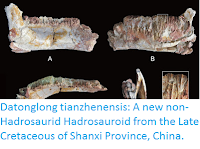Non-Avian Dinosaur remains from the Czech Republic are extremely rare, with only two such specimens described to date; DGSMU Pa 222, an isolated tooth crown from the Late Jurassic, attributed to a Tetanurine Theropod, and NMP Ob 203, a well preserved left femur from the Early Cretaceous attributed to an Ornischian Dinosaur. NMP Ob 203 was initially described in 2005, under the provisional designation IGP MZHLZ/2003/1, as an Iguanodontid, a name at the time widely used in Europe to describe any isolated remains that appeared generally Iguanodon-like. Since this time the development of databases containing precise measurements of large numbers of Dinosaur specimens has allowed the cladistic study of Dinosaur phylogenetics (computerised analysis of relationships within the
group based entirely upon shared common features rather than assumed
relationships) to revolutionise our understanding of the relationship between different Dinosaur groups, and assign many isolated bones and fragmentary specimens to precise taxonomic groups.
In a paper published in the Journal of Systematic Palaeontology on 25 September 2017, Daniel Madzia of the Institute of Paleobiology of the Polish Academy of Sciences, Clint Boyd of the North Dakota Geological Survey, and Martin Mazuch of the Institute of Geology and Palaeontology at Charles University, formally redescribe NMP Ob 203, and name it as a new Dinosaur species.
The specimen is named as Burianosaurus augustai, in honour of the Czech palaeoartist Zden ek Burian (1905–1981) and palaeontologist Josef Augusta (1903–1968). The specimen is an almost complete femur reconstructed as having been about 400 mm in length, and determined by histological analysis to probably have come from a young adult.
The holotype left femur (NMP Ob 203) of Burianosaurus augustai in (A) anterior, (B) posterior, (C) medial, (D) lateral, (E) proximal and (F) distal views. Abbreviations: 4tr, fourth trochanter; cd, condylid; eg, intercondylar extensor groove; fg, intercondylar flexor groove; fh, femoral head; gtr, greater trochanter; lc, lateral condyle; mc, medial condyle; mcl, insertion scar for M. caudofemoralis longus; mi, insertion scar for M. iliofibularis. The white arrow in A indicates where the histological sample was obtained. Madzia et al. (2017).
The phylogenetic analysis which enabled Madzia et al. to determine that this specimen represented a new species also enabled them to identify is as a member of the Rhabdodontomorpha, a poorly understood group of Ornithischians which branched off early in the history of the group. These Dinosaurs are known only from a few isolated specimens, though the wide geological and chronological distribution of these suggests that the group may have been more prevalent than we currently understand.
See also...
Follow Sciency Thoughts on Facebook.







